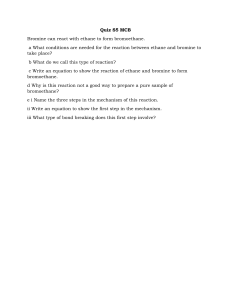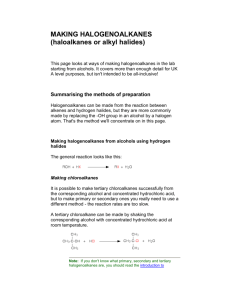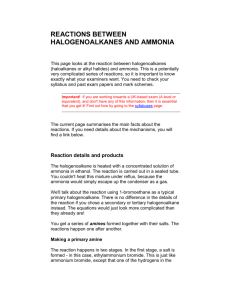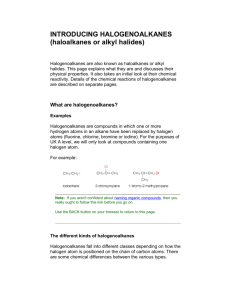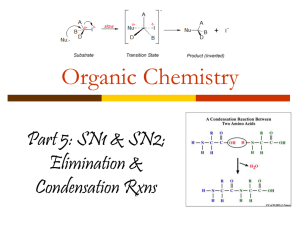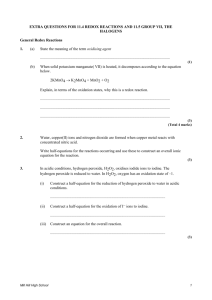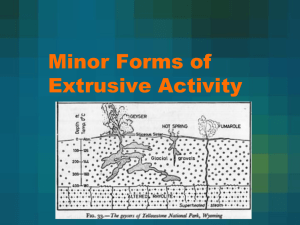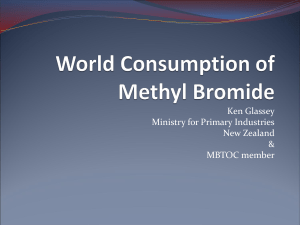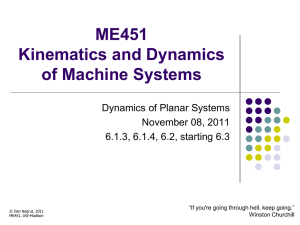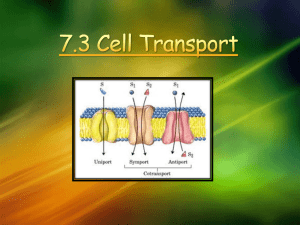File
advertisement
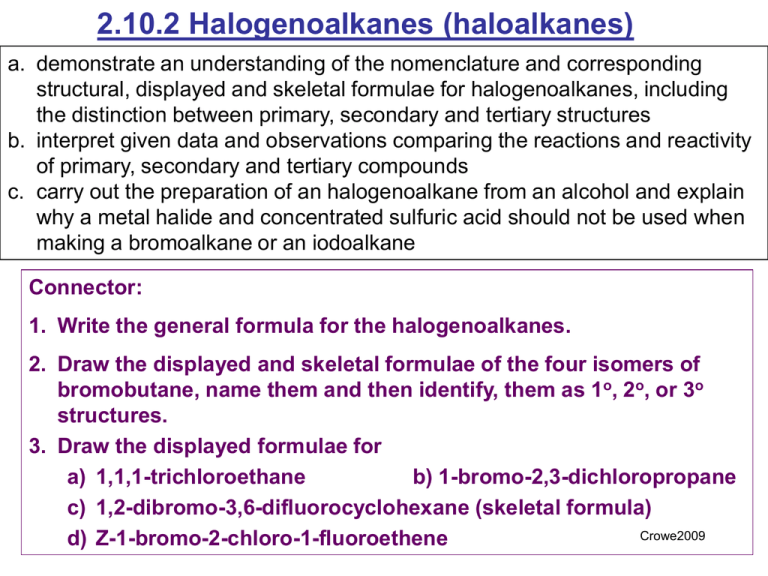
2.10.2 Halogenoalkanes (haloalkanes) a. demonstrate an understanding of the nomenclature and corresponding structural, displayed and skeletal formulae for halogenoalkanes, including the distinction between primary, secondary and tertiary structures b. interpret given data and observations comparing the reactions and reactivity of primary, secondary and tertiary compounds c. carry out the preparation of an halogenoalkane from an alcohol and explain why a metal halide and concentrated sulfuric acid should not be used when making a bromoalkane or an iodoalkane Connector: 1. Write the general formula for the halogenoalkanes. 2. Draw the displayed and skeletal formulae of the four isomers of bromobutane, name them and then identify, them as 1o, 2o, or 3o structures. 3. Draw the displayed formulae for a) 1,1,1-trichloroethane b) 1-bromo-2,3-dichloropropane c) 1,2-dibromo-3,6-difluorocyclohexane (skeletal formula) Crowe2009 d) Z-1-bromo-2-chloro-1-fluoroethene Halogenoalkanes (haloalkanes) General formula - CnH2n+1X where X = F, Cl, Br, I. Order of reactivity: RI > RBr > RCl > RF Primary, secondary or tertiary? 2o 1o Br Br butan-1-ol 1- bromobutane butan-2-ol 2- bromobutane 1o Br Br 3o 1- bromo2- methylpropane 2-methylpropan-1-ol 2- bromo- 2- methylpropane 2-methylpropan-2-ol 1,1,1-trichloroethane Cl Cl H C C Cl H 1-bromo-2,3-dichloropropane H H Br Cl Cl C C C H H H H F 1,2-dibromo-3,6-difluorocyclohexane Br Br F c) Z-1-bromo-2-chloro-1-fluoroethene Making halogenoalkanes from alcohols using hydrogen halides e.g. Making impure bromoethane in the lab The alcohol is treated with a mixture of sodium or potassium bromide and concentrated sulphuric acid. This produces hydrogen bromide which reacts with the alcohol. The mixture is warmed to distil off the bromoalkane. Practical 2.14 – 1. Preparation of Bromoethane Bromoethane has a low boiling point but is denser than water and almost insoluble in it. To prevent it from evaporating, it is often collected under water in a flask surrounded by ice. The big problem with this method is that the bromoethane contains unwanted by-products, and needs to be purified (See next slide.). It is therefore recommended that – A metal halide and concentrated sulphuric acid should not be used when making a bromoalkane or an iodoalkane, because conc. sulphuric acid is an oxidising reagent and unwanted side reactions occur. Practical 2.14 – 1. Preparation of Bromoethane.2 Impurities in the bromoethane include: •hydrogen bromide (although most of that will dissolve in the water if you are collecting the bromoethane under water); •bromine - from the oxidation of bromide ions by the concentrated sulphuric acid*; •sulphur dioxide - formed when concentrated sulphuric acid oxidises the bromide ions*; •unreacted ethanol; •ethoxyethane (diethyl ether) - formed by a side reaction between the ethanol and the concentrated sulphuric acid. What reagents should be used to obtain a good yield? Red phosphorus and bromine or iodine, heat under reflux Preparation of halogenoalkanes The alcohol is heated under reflux with a mixture of red phosphorus and either bromine or iodine. The pure halogenoalkane can be distilled off.
